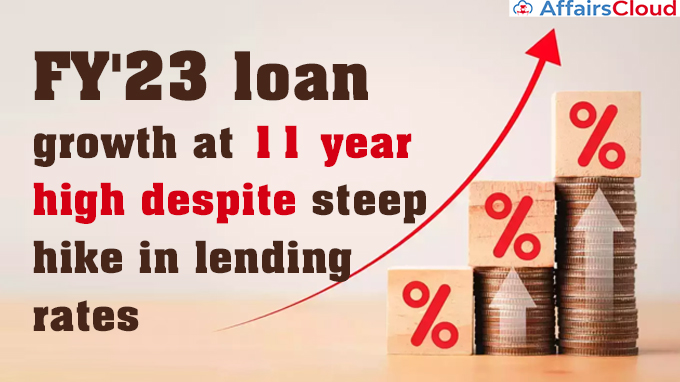 According to the Reserve Bank of India’s (RBI) Monetary Policy Report (April 2023), credit growth continued to outpace deposit growth in financial year 2022-23 (FY23) at an eleven-year high, despite banks fully transmitting lending rates linked to external benchmarks [250 basis points (bps)], which now account for nearly half of floating-rate loans.
According to the Reserve Bank of India’s (RBI) Monetary Policy Report (April 2023), credit growth continued to outpace deposit growth in financial year 2022-23 (FY23) at an eleven-year high, despite banks fully transmitting lending rates linked to external benchmarks [250 basis points (bps)], which now account for nearly half of floating-rate loans.
- In FY23, bank loans increased 14.6% while deposits increased just 9.6%.
- The rate of credit growth in FY23 was the greatest since FY 2011–12, when credit increased 17%.
- Significantly, lending rates surged the most in FY23.
The Monetary Policy Report (MPR) states that demand for credit is more closely related to economic activity than interest rates.
Monetary Policy Transmission
i.Since May 2022 to March 2023, banks have hiked their repo-linked External Benchmark-Based Lending Rates (EBLRs) by 250 bps to keep pace with the policy repo rate.
ii.The internal benchmark for loan pricing, the Marginal Cost of Funds-Based Lending Rate (MCLR), increased by 140 bps from May 2022 to March 2023.
iii.Between May 2022 and February 2023, the Weighted Average Lending Rate (WALR) on newly sanctioned rupee loans climbed by 173 bps, and that on outstanding rupee loans by 95 bps.
iv.The share of floating rate loans that are external benchmark-linked has increased from 44.0% in March 2022 to 48.3% in December 2022, making them the largest share of loans currently.
v.Similarly, the share of MCLR-linked loans fell from 48.6% in March 2022 to 46.1% in December 2022.
vi.The RBI repo rate is the primary benchmark for EBLR loans, accounting for 81% of all EBLR-linked loans as of the end of December 2022.
vii.The RBI found that bank deposits and credit move in tandem, based on an econometric analysis of monthly non-food credit and deposit data from all commercial banks from April 2007 to December 2022.
Revision in Deposit & Lending Rates
i.The 1-year median MCLR of Scheduled Commercial Banks (SCBs) increased by 135 bps from May 2022 to February 2023.
ii.WALRs on fresh rupee loans of SCBs raised by 149 bps from May 2022 to January 2023 as a consequence of an increase in benchmark rates for pricing loans.
iii.In the current tightening time period (May 2022 to January 2023), transmission to WALRs on fresh rupee loans from Public Sector Banks (PSBs) has surpassed that of Private Sector Banks (PVBs).
iv.From May 2022 to February 2023, there was an increase of 82 bps in the median term deposit rates, which are the average card rates on retail deposits.
Credit Growth Analysis by Rating Agencies
i.According to a report by credit rating agency CRISIL, bank credit is projected to rise by 15% in fiscal 2024, aided by a recovery in corporate credit, and leading signs indicate to a further decline in gross Non-Performing Assets (NPA), which might reach 3.8% by March 2024.
ii.According to a report by Care Edge Ratings, Credit growth in FY24 is anticipated to coincide with gross domestic product (GDP) growth.
iii.Furthermore, a slowdown in global growth as a result of rising interest rates, as well as rate hikes in India, may have an impact on credit growth.
iv.Despite a surge in bank credit in 2022-23, the credit-to-GDP gap remains negative.
Recent Related News:
i.In April 2023, the 6-members Monetary Policy Committee (MPC) of the RBI released its first bi-monthly monetary policy statement for FY24 (Financial year 2023-2024). The MPC has decided to keep the policy rates unchanged with the stance remaining focused on the withdrawal of accommodation.
ii.The MPC meeting was headed by RBI Governor Shaktikanta Das the other 5 members of the committee include: Shashanka Bhide, Ashima Goyal, Prof. Jayanth R. Varma, Michael Debabrata Patra, and Dr. Rajiv Ranjan. Click here to read more on policy rates.
About the Reserve Bank of India (RBI):
Governor– Shaktikanta Das
Deputy Governors– Mahesh Kumar Jain, Michael Debabrata Patra, M. Rajeshwar Rao, T. Rabi Sankar
Headquarters– Mumbai, Maharashtra
Establishment– 1st April 1935




